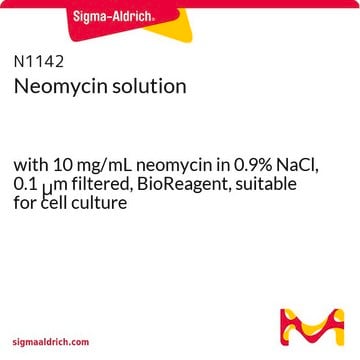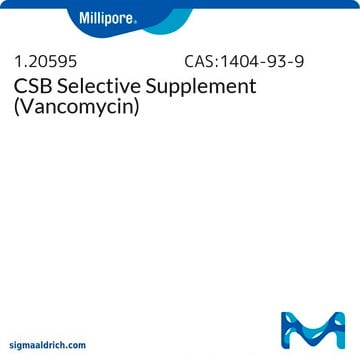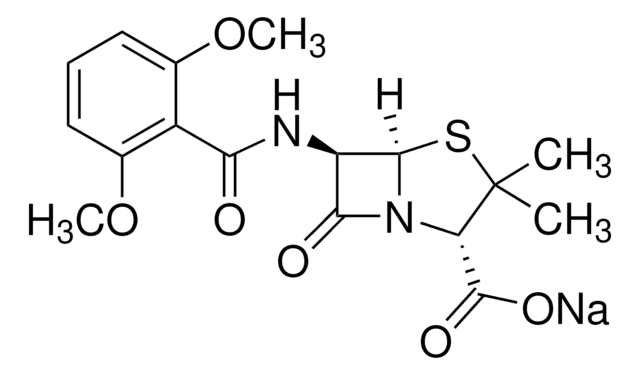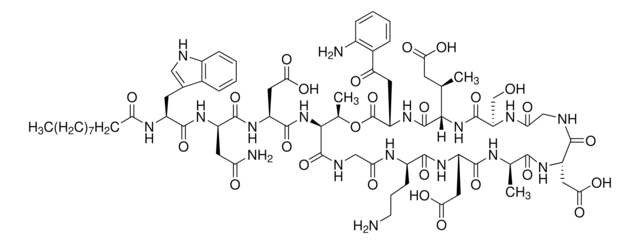SBR00001
Vancomycin hydrochloride
Ready Made Solution, 100 mg/mL in DMSO
Sinónimos:
Vancomycin HCL
About This Item
Productos recomendados
origen biológico
Streptomyces orientalis
Nivel de calidad
Formulario
liquid
concentración
100 mg/mL in DMSO
color
colorless to faint tan
espectro de actividad antibiótica
Gram-positive bacteria
Modo de acción
cell wall synthesis | interferes
temp. de almacenamiento
−20°C
cadena SMILES
[Cl-].Clc1c2ccc(c1)[C@H]([C@@H]3NC(=O)[C@H](NC(=O)[C@@H]6NC(=O)[C@@H](NC(=O)[C@@H]([C@@H](c7cc(c(cc7)Oc8c(c(cc6c8)O2)O[C@@H]9O[C@@H]([C@H]([C@@H]([C@H]9O[C@@H]%10O[C@H]([C@H]([C@](C%10)(N)C)O)C)O)O)CO)Cl)O)NC(=O)[C@H]([N+H2]C)CC(C)C)CC(=O)N)c4cc(c(cc4)O)c
InChI
1S/C66H75Cl2N9O24.ClH/c1-23(2)12-34(71-5)58(88)76-49-51(83)26-7-10-38(32(67)14-26)97-40-16-28-17-41(55(40)101-65-56(54(86)53(85)42(22-78)99-65)100-44-21-66(4,70)57(87)24(3)96-44)98-39-11-8-27(15-33(39)68)52(84)50-63(93)75-48(64(94)95)31-18-29(79)19-37(81)45(31)30-13-25(6-9-36(30)80)46(60(90)77-50)74-61(91)47(28)73-59(89)35(20-43(69)82)72-62(49)92;/h6-11,13-19,23-24,34-35,42,44,46-54,56-57,65,71,78-81,83-87H,12,20-22,70H2,1-5H3,(H2,69,82)(H,72,92)(H,73,89)(H,74,91)(H,75,93)(H,76,88)(H,77,90)(H,94,95);1H/t24-,34+,35-,42+,44-,46+,47+,48-,49+,50-,51+,52+,53+,54-,56+,57+,65-,66-;/m0./s1
Clave InChI
LCTORFDMHNKUSG-XTTLPDOESA-N
¿Está buscando productos similares? Visita Guía de comparación de productos
Descripción general
Aplicación
- for the assessment of the antimicrobial activity of vancomycin hydrochloride against Mycobacterium tuberculosis in nonreplicating persistence (NRP) using low-oxygen-recovery assay (LORA) and against a luciferase reporter strain of M. tuberculosis in a fermentor-grown culture adapted to low oxygen conditions
- for the estimation of biomass in a culture of various strains of bacteria
- as a positive control for E. coli and Staphylococcus aureus in antibacterial activity assay.
Acciones bioquímicas o fisiológicas
Envase
Almacenamiento y estabilidad
Otras notas
Palabra de señalización
Danger
Frases de peligro
Consejos de prudencia
Clasificaciones de peligro
Resp. Sens. 1 - Skin Sens. 1
Código de clase de almacenamiento
10 - Combustible liquids
Clase de riesgo para el agua (WGK)
WGK 2
Punto de inflamabilidad (°F)
188.6 °F - closed cup
Punto de inflamabilidad (°C)
87 °C - closed cup
Elija entre una de las versiones más recientes:
Certificados de análisis (COA)
¿No ve la versión correcta?
Si necesita una versión concreta, puede buscar un certificado específico por el número de lote.
¿Ya tiene este producto?
Encuentre la documentación para los productos que ha comprado recientemente en la Biblioteca de documentos.
Los clientes también vieron
Nuestro equipo de científicos tiene experiencia en todas las áreas de investigación: Ciencias de la vida, Ciencia de los materiales, Síntesis química, Cromatografía, Analítica y muchas otras.
Póngase en contacto con el Servicio técnico









